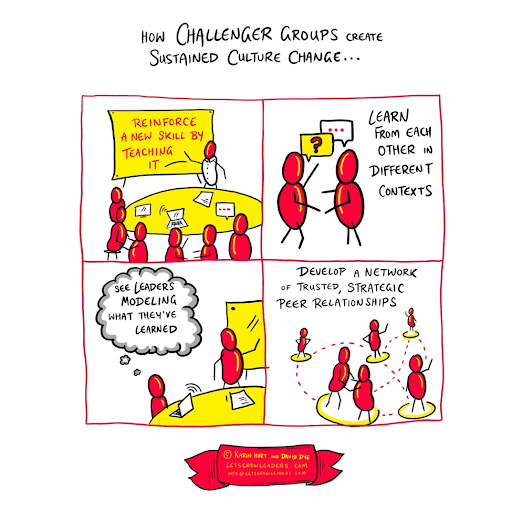Share:
Karin Hurt, Contributor
David Dye, Contributor

The Great Resignation shows no signs of slowing down, with many workers engaging in job switching rather than leaving the labor force altogether.
According to a recent survey by Willis Towers Watson, 53% of employees said they were “open to leaving their employer.” And a majority, 44%, said they were actively looking for a new job or were planning to begin looking for a new one.
Yes, money matters. If you’re not paying a competitive wage, start there. But beyond pay and benefits, what are employers offering employees to get them to stay?
To retain employees, employers are investing in developing human-centered leadership at all levels of the organization who let employees know they’re valued, model core values and behaviors, provide coaching opportunities, and foster a healthy system of feedback between employees and leadership.
Your employees yearn to be truly seen, understood, invested in, and valued. They need clarity about the work they are doing and why it matters. The person who can do that best for them is their manager.
If you want to retain employees and build a sticky culture in which greater profitability, lower stress, better customer service, and more trust between leadership and employees are the norm, invest in developing human-centered leaders who know how to do these things well, not just conceptually, but practically.
Three Practical Approaches to Retain Employees
Here are three practical approaches to developing human-centered leaders at every level of your organization:
- Identify and teach a consistent set of behaviors at every level
- Accelerate performance and connection by helping your leaders serve as coaches for their teams
- Give your leaders practical ways to encourage contribution and new ideas
It can be tempting to “check the box” and train your high-potential employees or grab an off-the-shelf “leadership” training course, but if retaining employees is your goal, you’re going to want to ensure your leadership development creates real culture change.
Identify and Teach a Consistent Set of Behaviors at Every Level
Employers who truly invest in leadership development as a vital component of their retention strategy have one thing in common. They, along with their executive teams, teach a consistent set of behaviors at every level of the business.
This can happen in a variety of ways. You can include your leadership team in the training alongside your managers. You can train the executives first and then involve them in reinforcement and application (more on that later).
What matters is consistency and simplicity. Focus on a few key techniques that are easy to replicate. In our programs, we start with six foundational concepts that we teach, repeat, and help teams to apply consistently, across contexts.
These include tools to show up with confident-humility, focus on the MIT (most important thing), check for understanding, communicate consistently, hold accountability conversations up, down, and sideways, and deal with team conflict in a way that improves results and relationships.
Here’s an example of the results from implementing these consistent practices. This client listed retaining employees as a top reason for investing in leadership development. Now, leadership is no longer a factor in their exit interviews, and they’re significantly outperforming their industry peers.
You can’t possibly give people a tool for every situation they’ll encounter, but if you can ground everyone in essential tools they can use consistently, you will foster trust, facilitate connection, and accelerate performance.
Give Your Leaders the Tools and Infrastructure to Serve as Team Coaches

Another best practice to help retain employees is to equip managers with skills and infrastructure to coach their teams for deeper trust, stronger connections, and improved performance.
When you involve leaders as coaches, your leaders have a structured way to go back and model what they’ve learned, and they have an easy way to cultivate those competencies in their teams.
Leaders coach and reinforce the skills they’re learning. They facilitate practical conversations to build trust and connection, and they coach their teams to take their performance to the next level.
You might be thinking, “It’s hard enough to get my managers to attend a leadership development program. Now you want them to be leadership coaches too?”
We get it. This may all seem like a bit much because no one has time for meetings that don’t achieve learning outcomes and business results. But we’ve seen busy leaders embrace their role as coaches because these are high-ROI engagements that achieve multiple business outcomes.
First, managers practice skills that directly apply to their daily leadership: asking great questions; drawing reluctant team members into the conversation; listening without bias; reflecting on what they’ve heard and running a great meeting.
Second, these leadership coaching conversations focus on real business priorities and outcomes. They’re practical. They make work smoother, improve team dynamics, and increase productivity.
And third, your leaders are building deep trust and connection with and within their teams, which is so vital to retaining employees.
Give Your Leaders Practical Approaches to Invite Ideas and Contributions
If you want to retain employees, you’ve got to listen to them and their ideas. They need to know they have a voice and that it matters.
Our recent research on psychological safety and innovation revealed some interesting statistics:
- 40% of employees said they lacked the confidence to share their ideas
- 67% said their manager operates around the notion of “this is the way we’ve always done it”
- 49% said they’re not regularly asked for their ideas
- 50% said nothing would happen with their ideas anyway so “why bother.”
Yikes. Those statistics seem remarkably consistent with the number of folks looking around for another job.
If you want to retain employees, you need to know what’s on their hearts and minds. Your managers are in the best position to make it safe and to proactively ask.
This takes more than an open door; for many employees, it still takes some level of courage to walk through the open door. One way to do this is to teach your leaders the art of asking “courageous questions.”
The Art of Courageous Questions
A courageous question differs from a generic “How can we be better?” question in that a courageous question is specific, humble, and assumes that improvement is possible. You ask courageous questions to get curious about what’s really going on, not to respond immediately.
When you ask a courageous question, you:
Get specific.
A courageous question focuses on a specific activity, behavior, or outcome.
For example, rather than ask “How can we improve?” ask “What is the number one frustration of our largest customer?”
Or, “For the next two quarters, our most important priority is customer retention. We need every idea we can get to help keep our best customers. What is THE NUMBER ONE REASON you see customers leave? What’s THE GREATEST OBSTACLE to keeping our best customers? What’s ONE VITAL LOW-COST ACTION we can take to improve our customer’s experience?”
Stay Humble
Next, a courageous question creates powerful vulnerability.
When you ask any of these sample questions, you are implicitly saying “I know I’m not perfect. I know I can improve.” This is a strong message—if you sincerely mean it.
You send the message that you are growing and want to improve. This, in turn, gives your team permission to grow and be involved in the process themselves. It also makes it safe to share real feedback. When you say, “What is the greatest obstacle?” you acknowledge that there is an obstacle, and you want to hear about it.
Humility is at the heart of the question that Don Yager, Chief Operating Officer of Mural Corporation, consistently asks his frontline team: “What are our policies that suck?” That humble question quickly identifies anything that’s getting in the way of a great customer experience.
Helping your leaders get better at asking courageous questions to learn what’s really happening is vital when working to retain employees. And of course, they need to learn to respond well to what they hear—with gratitude, information (about how the idea will or will not be used and why), and an invitation to continue contributing.
Leaders at every level of your organization are your secret weapon to retain talent and create a sticky culture. Consistent human-centered leaders who roll up their sleeves to invest in their teams, stay close to what’s going on, and invite their teams to contribute ideas will attract and keep top talent.

Karin Hurt helps human-centered leaders find clarity in uncertainty, drive innovation, and achieve breakthrough results. She’s the founder and CEO of Let’s Grow Leaders, an international leadership development and training firm known for practical tools and leadership development programs that stick.

David Dye helps human-centered leaders find clarity in uncertainty, drive innovation, and achieve breakthrough results. He’s the President of Let’s Grow Leaders, an international leadership development and training firm known for practical tools and leadership development programs that stick.


